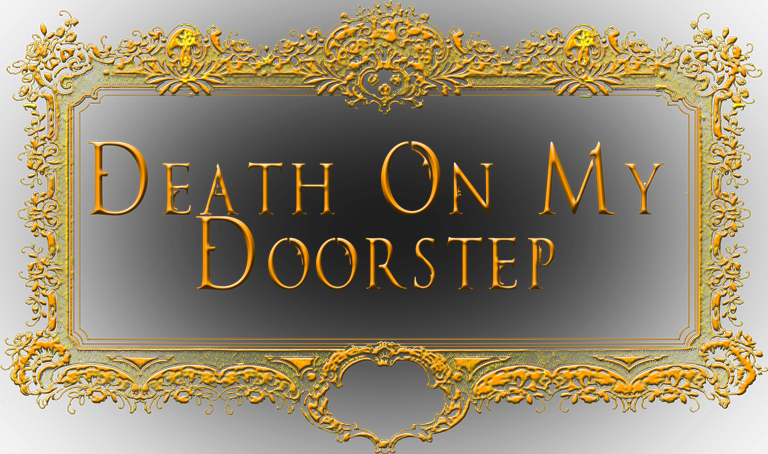1/ Brough Railway Station Death, near Hull, April 1883

2/ Goole Bathing Fatality, June 1883

3/ Old Sugar House, Hull, (Building Collapsed- Seven Dead) September 1868
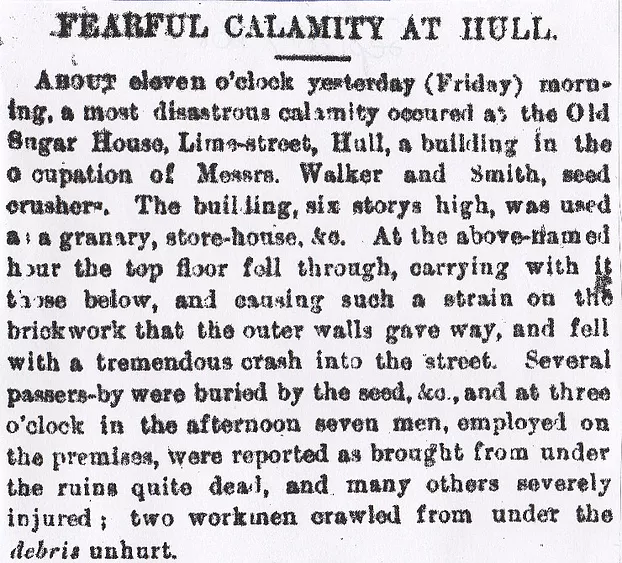
4/ River Humber/Hessle, (Corpse Washed Ashore) June 1859
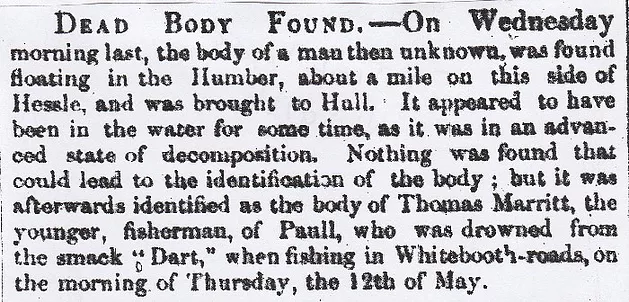
5/ Hull, July 1859 (Man Drowned)
About four o’clock on Wednesday last, a labourer named James Sayers found the body of a man floating in the Queen’s Dock, having been brought to the surface by the motion of a packet in the water. On being taken out it was recognised as that of Joseph Heppastall, moulder of Scott St. He was last seen alive about eleven o’clock coming out the Lugger Inn on the High Street very drunk.
6/ Burton Pidsea Suicide, September 1875

7/ Goole Child Murder, May 1881

8/ Hull December 1876 (Human Remains)
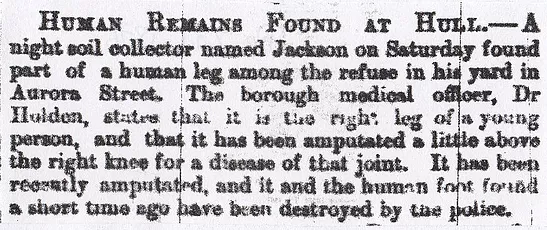
9/ Humber/North Sea, (Hull Steamer- Lady Drowned) July 1866

10/ Wressle Fatal Railway Accident, November 1862

11/ No.4, Elizabeth Place, Peter St, Hull, (Double Fatality) December 1884
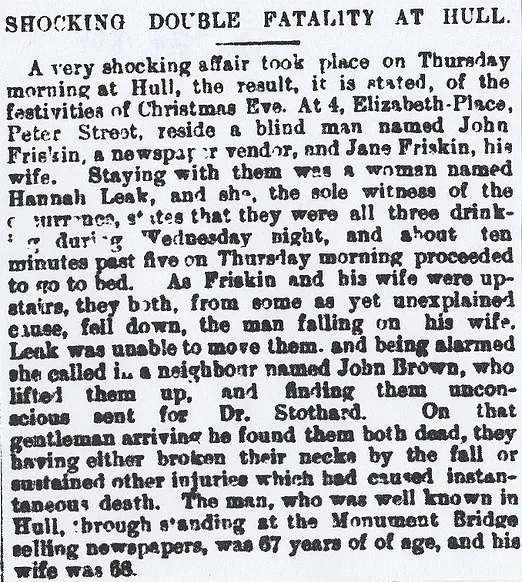
12/ Hull Balloon Fatality, May 1877

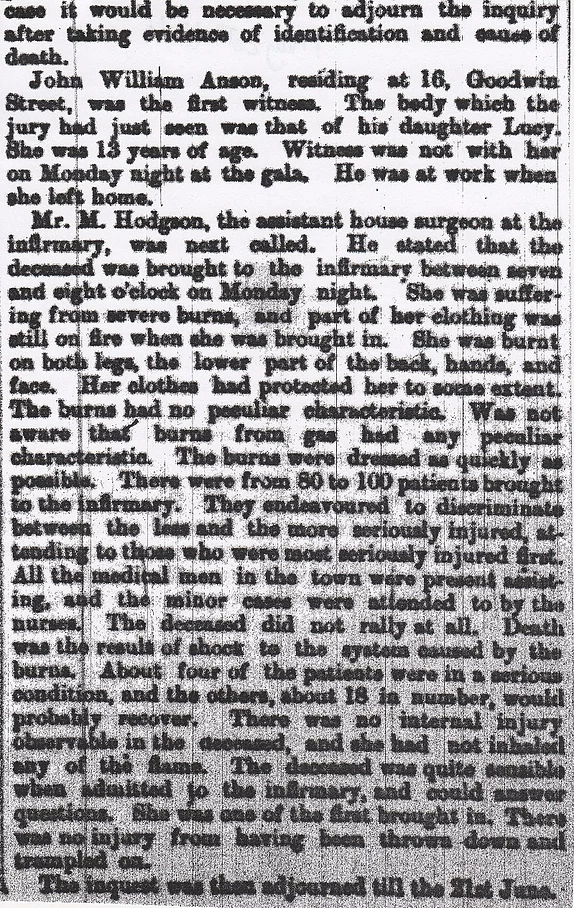
13/ Prospect Street, Hull, (Child Skeleton) June 1891
A child’s skeleton was found in the roof of a house that was having some building repairs done to it, in Prospect Street, Hull, East Yorkshire. The infant was wrapped in some old clothing and a newspaper which had the date of October 1871; more than twenty years ago.
14/ Sutton/Groves Ferry area, Hull, (Twenty Lives Lost?) December 1848
A shocking accident has taken place near the Kingston Cotton Mills, Hull, resulting in the loss of around twenty or so lives. The mills are just above the North Bridge and the workers used to cross the River Hull by means of a boat that kept on the Sutton/Groves Ferry area. At six a.m., around 25-30 stepped on board to make the crossing. The boat was in a poor condition, it was early on a December morning, so fairly dark and the heavy rains had caused the current to be stronger than the norm, so it was asking for it really. The warp parted from the post and the boat was out of control, then she tipped over and the passengers were thrown into the river. The majority were young lasses that worked at the mill and although seven have been brought to land, there are around fifteen still missing. The probability is that the remainder of the missing have been washed into the Humber by the strong current.
15/ The Humber, (Man Drowns) June 1883
On Sunday night six keelmen were returning from New Holland on the Lincolnshire side to Hull in a boat, and whilst on the Humber, the boat capsized and all of them were immersed in the water. The accident was seen from the shore and several boats at once put off and five of the men were rescued. The sixth, whose name was Samuel Attwood was not seen again, and it is believed that he was drowned.
16/ Bridlington Landslip Death, August 1855
Miss Lamplugh and Miss Oxley went for a stroll along the sands at Bridlington quay, when Miss Oxley went to get a drink from the water spring which issued from the cliff at Hilderthorpe, while Miss Lamplugh went back into town. Miss Oxley said she would follow her up but she never returned home. On a search being made, Miss Oxley was found under thirty tons of rock, as a landslip had occurred at the cliff. The rock had fallen on her while she was sat down having a rest and she ultimately died of suffocation. She was only twenty-five years of age.
17/ Victoria Terrace, Stamforth Place, Hull, (Scalded to Death) June 1889
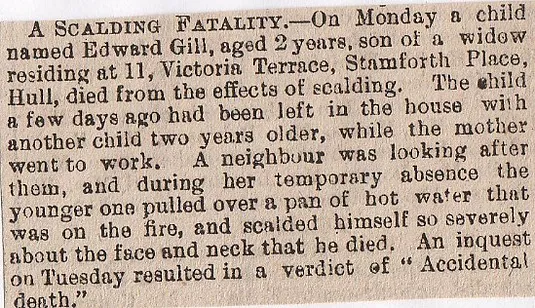
18/ Spurn Head Light-House, December 1861
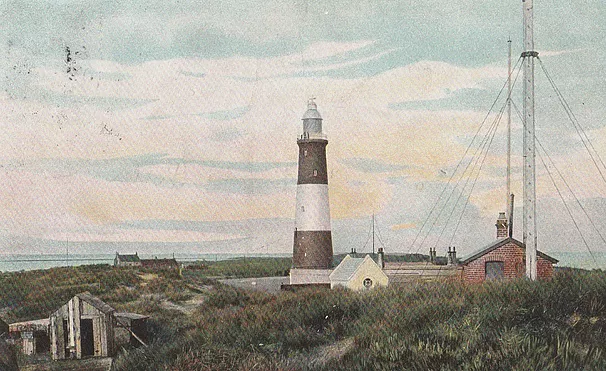
An inquest was held at the Coach and Horses Inn, Cleethorpes, before Mr Marris, coroner, on view of the body of Mr Henry Hammond, fifty-two-years of age who died suddenly on board the light-ship off Spurn. It appears that the deceased had enjoyed uninterrupted good health all his life and had never been known to complain of indisposition until the morning of his death. He seems to have gone to his berth towards evening, where he was shortly afterwards found dead. The surgeon gave evidence that in his opinion the deceased had died from heart disease. The jury returned a verdict accordingly.
19/ Hull Fisherman Suicide, April 1890
George Broadley, a fisherman from Hull, shot himself at that city. He accompanied a woman named Reynolds to her house and wanted to stay the night. She refused, then he pulled out a revolver and shouted: “It’s you or me!”. She scrambled from the building and ran to a police station. She met a copper on the way there and explained what had happened. Broadley saw the policeman and went back to Reynolds’s house with the policeman in pursuit. At the house, Broadley shot at the policeman twice, missing him both times, then put the gun to his temple and shot himself.
20/ Hull Child Murder, 28th May 1885
At Hull yesterday a young woman named Isabella Hewson went to the Central Police Station and stated that she had hanged her son. On visiting the woman’s residence the police found the boy suspended from the ceiling by a piece of clothes-line. He was quite dead. The woman was medically examined but there was nothing to indicate insanity and having been brought before the magistrates, she was remanded for eight days.
21/ Hull Child Murder, May 30th, 1885
At Hull yesterday a coroner’s jury returned a verdict of wilful murder against a single woman named Isabella Hewson who, on Wednesday, hanged her child aged two-years and gave herself up to the police.
22/ Aldbrough Double Suicide, July 1859 (Says Aldborough-but incorrect spelling)

23/ Beverley Murderous Attack, September 1878
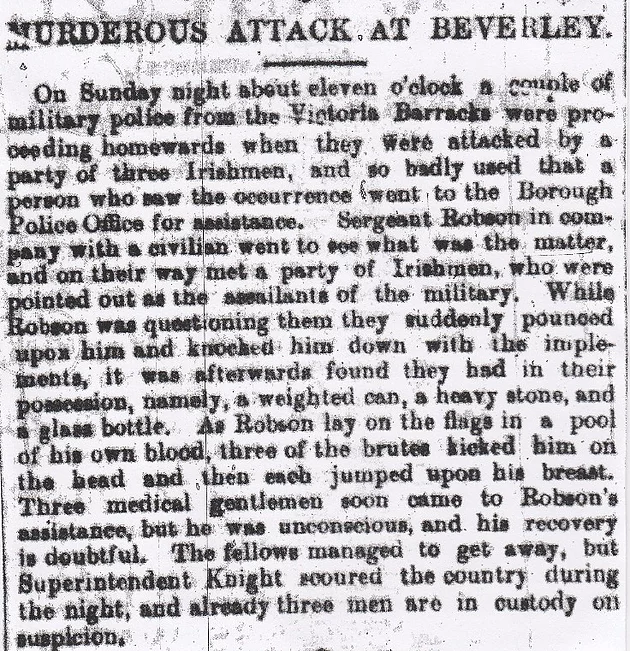
24/ Helperthorpe Suicide, near Driffield, February 1873
The parents of the victim, one Margaret Pickering aged twelve, were the innkeepers at Helperthorpe. The father accused her of nicking some money from the till which she claimed was untrue. Her sister had told the father that she spent money like it was going out of fashion in the village (It was two shillings), so the mother decided to hit her with a leather strap on her shoulders but she still denied any knowledge of the theft. Margaret went to the kitchen and then a scream bellowed out. The father found her on the floor and she garbled some last words to him: “You don’t know what you have done. I have taken some of the poison that mother killed the mice with, and if you look in the oven, you will find the paper”.
When he looked in the oven he found the Battle’s Vermin Killer paper. His daughter died in agony shortly after.
25/ Between Drewton and Weedley Tunnels, (Body on Tracks) August 1889
On Tuesday morning about nine o’clock, the body of a ganger named John Flint, in the employ of the Hull and Barnsley Railway Company and residing in Weedley Springs, was found on the line between the Drewton and Weedley tunnels. It was fearfully mutilated and deceased is supposed to have been run over by a passing train. He was forty years of age and leaves a widow and family.
26/ Walmsley Street, Hull, (Epileptic Found in Fire) December 1915
A terrible burning fatality occurred at Hull on Monday. A milkman called at the house in Walmsley Street and failing to get a response to repeated knocks he entered the house and found the charred body of a widow named Brown lying on the hearth. In the opinion of the medical man, the unfortunate woman had had a fit and fallen with her head in the fire. Deceased’s daughter was at Grimsby visiting friends.
27/ Bear Street, Hull, (Murder/Suicide) July 1895
On Monday night at Hull, Thomas Parkinson, ship’s steward, went to the house of his sweetheart, Miss Ormond, residing in Bear Street. They had a quarrel during which Miss Ormond said that she did not want Parkinson’s attentions. The latter having declared that she should not have anybody else, shot her in the back with a revolver, then shot himself in the breast inflicting a fatal wound. The young woman is expected to recover.
28/ Burton Pidsea Murder Confession, August 1905
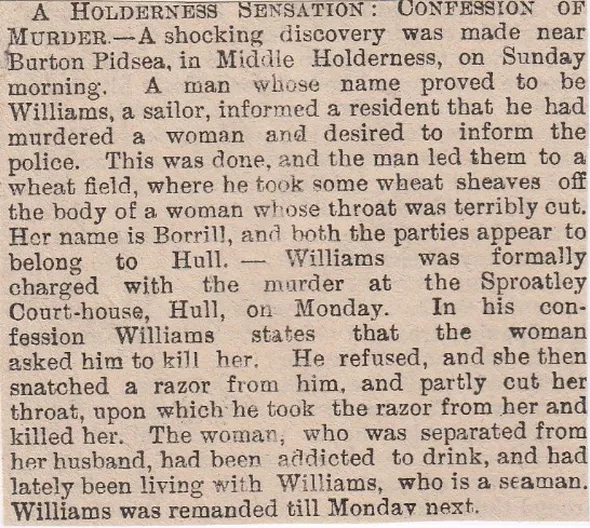
29/ Cross St/West St, Hull, August 1859 (Pub Fatalities)
A fatal accident has occurred at the Lord Durham public house situated in Cross Street, West Street, Hull. The landlord George Taylor had to tap a puncheon of rum so he got a red-hot poker to make the hole bigger because the hole was too small. The spirit ignited, burning him on his hands and arms and his hair was singed off. He ran into the street and people rushed to help him. A fire hose and engines arrived but by now the pub was fully alight. Two of Taylor’s kids were enveloped in flames, they were only four and six years old and were rushed to a hospital. There were another two children in the pub, namely Emily Clifton aged five, the daughter of Henry Clifton of Vincent Street and Mary Stewart a four-year-old whose parents reside opposite the Lord Durham. Clifton was badly burned but not as bad as the Taylor’s and later on that night the three children died the following day. Another body was found in the ashes of the pub, burned to a cinder.
30/ Hull Docks Murder? August 1860
It appears that two German captains were seen on Monday morning in company with a female at the Docks at Hull. A custom-house officer observed them in close conversation, then he heard a violent scream and on looking round he saw the woman struggling in the water. He ran to the two captains and asked them what they had done, but they made no reply. The girl was rescued and brought onto land where she gave one sigh, then expired. The two captains had scuttled off making no effort to rescue the girl. She was later identified as Lucy Gray aged twenty-five. Both captains are now in custody and were taken to the stipendiary magistrate in Hull, who remanded them until today. (What happened to them?)
31/ No.30 Regent Street Suicide, Hull, June 1861
James Akroyd and Charles Brook had been out on the Saturday evening and went back to Brook’s house, 30 Regent Street at 12-30. They went in the backyard and Akroyd was entering the house when he heard the report of a pistol. He saw Brook lying on the floor with a gunshot wound to the head and the pistol next to his body. He was lifted into the kitchen and medical assistance was procured but to no avail, as he died an hour or two later. When examined Brook had another pistol in his other pocket, suggesting premeditation, and the only motive for the rash act is that Brook was addicted to betting on the horses.
32/ Porter Street Suicide, Hull, February 1863
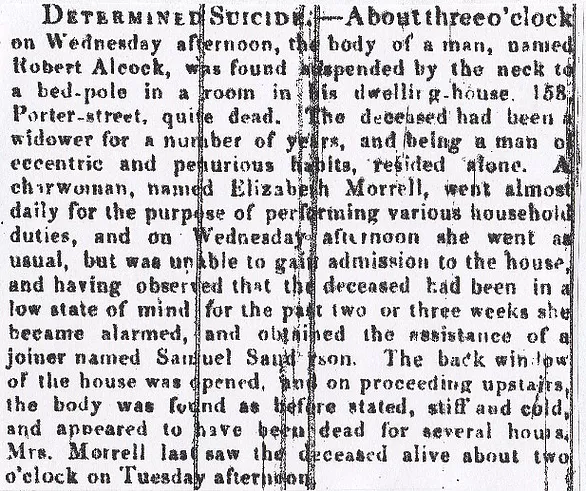
33/ Howden Station Fatality, February 1863
A fatal accident at Howden Station near Hull, to a guard named John Sight, occurred on Thursday. It was his business to act as the guard on the 7-10 a.m. train to Leeds but he overslept and missed it, and came by a later one which arrives at Howden at 11 a.m. intending there to join his own train which left Hull on its return journey to Leeds at 10-40 a.m. On the arrival of this train at Howden at 11-25 a.m. and whilst it was in motion he tried to clamber aboard, but slipped and fell between two carriages which ran over him. Both legs were crushed and he was taken to the ladies waiting-room. He lingered for about four hours then he expired. He was from Leeds and leaves a wife and four children. Verdict-“Accidental Death”
34/ No.8, Arnott’s Square, North Street, Hull, January 1864 (Suicide)
A suicide was committed in Hull, by Thomas Iveson a 42-year-old postman, who lived at 8, Arnott’s Square, North Street, Prospect Street. He had been unemployed for some time and his neighbour, Louisa Dann, found him at about one a.m., at his home. She heard moans and forced open the door and asked him what he was doing. He replied, “I have killed myself”. A surgeon was fetched but he died from the terrible lacerations on his throat and on one of his arms. P.C.Sanders found a pen-knife on the mantle-piece, covered in blood and also a note on which was written “Dear Jane”-meaning his wife. It read:
“I will be a burden to you and my friends no longer. Farewell! Bury me in Hedon, and forgive me”
His wife was out when he did this and he has no family. -Verdict “Temporary Insanity”.
35/ At the rear of the Asylum (Boys Drown) April 1864
Two lads, one aged twelve and one aged thirteen went with three mates to a field at the back of the Asylum, where there is a pond, to bathe. The lads, William E.Connolly and John Fernes, stripped off and entered the water. After a few minutes, their companions saw them sinking, with the depth was greater than any of them had anticipated. Unable to swim to save them they ran to the junction on the railway line to get the pointsman, William Lazenby to help them. He dragged the lads out but they were quite dead and they were taken to their homes, Connolly to West Street and Fernes to Mill Street.
36/ No.19, Mason Street Suicide, Hull, May 1865
On Saturday morning last, an old woman named Ann Eaton was found to have committed suicide by hanging, in the house No19, Mason Street. A servant girl employed there found her body and at once gave information to P.C.Elvin, who was on the beat in the area. Elvin forced the room door open and cut the body down from the bed-post, but she was dead. Ann Eaton was about seventy-four years of age.
37/ Hull Town Hall Fatality, August 1865
An accident occurred at the New Town Hall in Hull which ended with a fatality. A decorator, William Funicane of London, was painting the ceiling of the grand staircase. He walked along a plank which had become displaced at the end, then it gave way and he was thrown down about twenty feet. He had a fractured skull and was taken to the Infirmary. He leaves a widow and three children and the verdict was one of “Accidental death.”
38/ Sutton Drain, (Body Found) February 1866
The body of a young woman was found in the Sutton Drain. It was removed to the dead-house where it was recognised by Mrs Raby, Clean Alley, Witham, as that of her daughter Jane aged seventeen years and who left home about three weeks ago stating that she would commit suicide. An inquest was held on the body and the verdict was “Found Drowned”
39/ Old Harbour Infanticide, April 1867
A young woman, Elizabeth Nelson, who is in custody of Hull police was charged on her own confession with the murder of her infant son. She alleged she had thrown the body in the Old Harbour and the body of an infant was found at Brough Haven. A nurse said she recognised it as that of Nicholas Nelson, son of the woman living at Machell Street, Hull. The mother came in labour to the Union on February 17th last. She left the Union on March 13th, the child being registered but not baptised. The mother took the child while the nurse was having dinner, then left with it fully clothed, but was found naked. The mother was not kind to the child and called it ill-names, but she’ll be charged with wilful murder.
40/ Above story continued, August 10th 1867

Judge passed sentence of Death.
41/ Southcoates Station Fatality, August 1869
A shocking accident occurred at Southcoates Station on the Hull and Withernsea branch of the North-Eastern Railway. John Roe, a porter, had been there a number of years in the service of the company, while fulfilling his duties had occasion to cross the lines about the time the express from Withernsea was due, he did not observe the train coming upon the other side and was run over and terribly mutilated, his arm being cut off and his head fearfully crushed. The surgeon was called for but could offer no assistance, death following within fifty minutes. A verdict of “Accidental Death”.
42/ Passage Street Fire Deaths, Hull, March 1870
A fire broke out on the premises occupied by an emigrant agent named Weber, in Passage Street, Hull. A young woman jumped from a bedroom window into the arms of a policeman and escaped unhurt. Two hours later when the fire had been extinguished, the bodies of Mrs Weber along with a man and a child, were found dead.
43/ Wilberforce Buildings, High Street, Hull, (Body in Chimney) June 1870
A singular discovery was made in a chimney in the office of Mr Norman, Wilberforce Buildings, High Street. Some workmen were engaged in the chimney in that part of the offices when they came across the skeleton of a man, which, by its appearance had been in that position for many years. A considerable time since the office was used as a banking business, at which time an entrance was made by thieves and around £90 was stolen. The only conclusion to this is that the thief while being surprised, made off up the chimney and whilst in such a confined position, had been suffocated.
44/ Dock Street Murder, Hull, March 1871

45/ New South Bridge, Hull, August 1874
Early on Tuesday morning last, a man whose name is unknown, was seen to run towards the new South Bridge which crosses the River Hull to the east side of town and jump over the gate, trying to avoid paying to cross it. The bridge, however, is kept open during the night and a chain put across it to prevent accidents. He jumped over the chain and instead of alighting on the bridge, he fell into the dark abyss of water below in the river where a strong tide was running at the time. A boy heard a splash and a scream and told the keelman, who tried to grapple hold of the man with a hook but found nothing. The river was dragged but up to Thursday morning, no body had been discovered.
46/ The steamer Sappho Murder, March 1875
During the past week, a memorial has been laid in the Town Hall in Hull, and mostly signed in favour of a commutation of the sentence of death passed on Robert Searle, alias Edgely, for the murder by stabbing, of a fellow fireman named McCannell on board the steamer Sappho. He was sentenced at the York Assizes on Friday the 19th inst. and at the time insanity was pleaded, Searle denying all knowledge of the occurrence. The prisoner at the time of the murder, cut his own throat and for some time life was despaired of; and it was stated in evidence that he had tried suicide once or twice before. (What happened?)
47/ The steamer Navarino Death, July 1875
An inquest was held on Wednesday night last, on the body of a man named Walter Martin who was killed on the previous day, on board the steamer Navarino while loading for New York. He fell into the hold and a cask of alum falling upon him, death was instantaneous.
48/ Bank Side Mill, near Sculcoates Gas Works, (Boiler explosion) September 2nd, 1876
A disastrous accident occurred at the Bank Side Mill near Sculcoates Gas Works. As the mill was in full work, the boiler which drives the machinery burst with a tremendous noise scattering the fragments of the building in all directions. As soon as the smoke and dust cleared away it was found that one of the workmen, the engine driver, was literally blown to pieces, while the owner of the mill, his three sons and another workman were dreadfully scalded. All the injured men were said to be in a precarious condition. They are all conscious but suffering horribly and little hopes are entertained for one or two of them.
49/ Bank Side Mill, near Sculcoates Gas Works, September 9th, 1876

50/ Hull Murder, March 2nd, 1878
At the Hull Town Hall on Wednesday, an inquest was held touching the death of Mrs White, who was stabbed on the 18th inst by Vincent Knowles Walker and who died a few minutes afterwards. Several witnesses gave evidence bearing out statements made at the time the act was committed and ultimately the jury returned a verdict of “Wilful Murder” against Walker.
51/ Hull Murder, March 16th, 1878
Vincent Knowles Walker was charged on remand with the murder of Lydia Wills White on the 18th ult. Mr Terry appeared for the prosecution and stated that the prisoner had been remanded in order that a plan of the premises, No 37, Nile Street, where the murder was committed, might be prepared. The prisoner was formally charged after the plan was submitted and he replied “No!” to the question of whether he had anything to say.
A couple of weeks later he was found guilty and sentenced to death, but then a week after that in early April, a petition praying for the commutation of the capital punishment to penal servitude for life, suggesting that he received extreme provocation which would warrant a life sentence.
52/ Sutton-on-Hull Suicide, September 1878
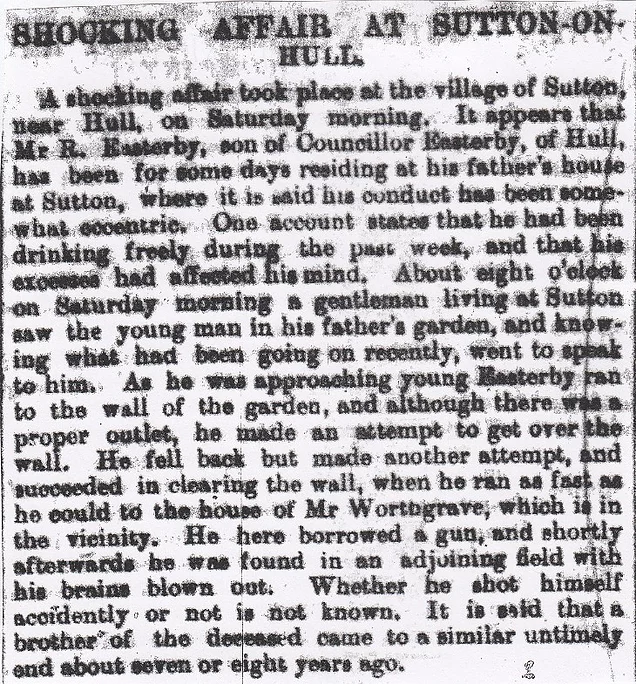
53/ Marfleet Drain Suicide, August 1879
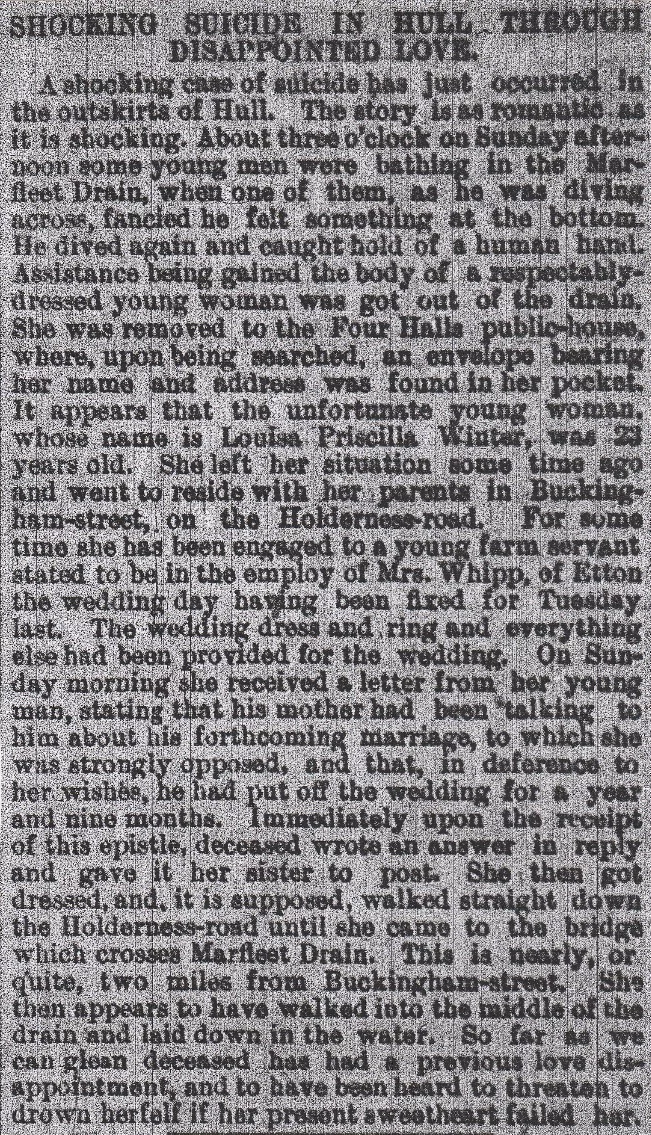
54/ Hull Wife Murder, June 1881
A Hull fisherman named James Ash, gave himself up to the police on Wednesday stating that he had murdered his wife because she had accused him of infidelity. On going to an address given the police discovered the woman lying on the floor quite dead, there being a deep stab in the chest. At seven p.m. the coroner’s jury returned a verdict of “Wilful Murder”, against James Ash for the murder of his wife.
55/ Victoria Docks, Hull, (Child Deaths) September 1882
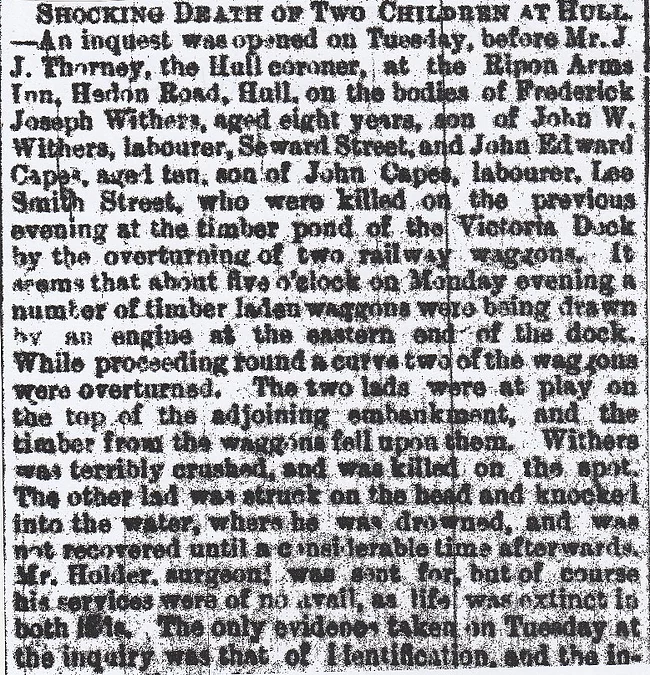
quest was then adjourned until October 5th.
56/ Hull Docks Fatality, October 1885
On Tuesday morning a fatal accident occurred on board the Wilson Liner Marengo, which was lying in the Hull Docks. James Delaney a labourer, was in the hold engaged in receiving bales of wood pulp when the winch slipped out of gear and the bale being lowered fell and struck him on the head. He was picked up by fellow workers, but exclaimed “Oh Dear”, and then expired. He was fifty-three-years of age and resided at 67, North Street.
57/ Chalk Lane Suicide, Hull, May 1886

58/ West Dock, Avenue End, (Railway Death) December 1886
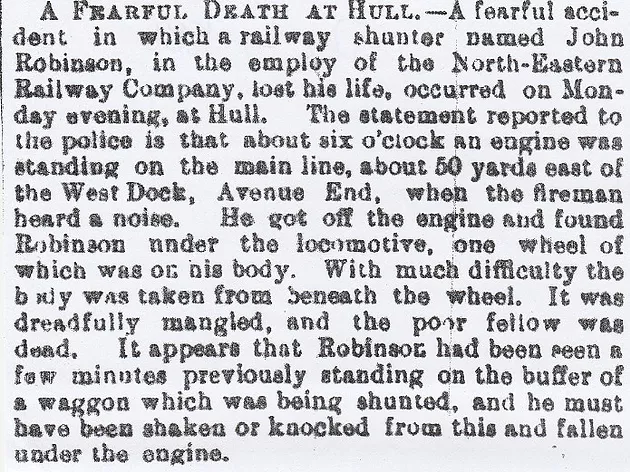
59/ H.M.S.Rupert, Hull, (Fatal Accident) June 1887

60/ Prince’s Dock Child Murder, Hull, July 1888
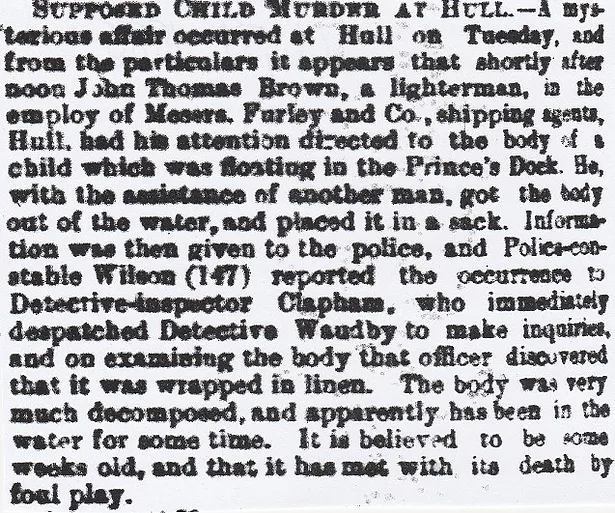
61/ Cherry Burton church Fatality, near Beverley, December 1875
While the service was in flow in Cherry Burton parish church, a clock weight came through the belfry roof and landed on the young housemaid from the rectory. Her injuries are so severe that there is no hope of her recovery and the young chap sat next to her was also badly hurt. The sad part of the story is that the two who were hurt in the accident were getting married this week.
62/ English Street Suicide, Hull, October 1877
Mrs Anderson, the wife of George Anderson, a labourer who works for the North Eastern Railway Company, was cleaning up one of their properties in English Street, Hull, for the purpose of moving in. She went upstairs when a terrible stench hit her nose and checking around she found the corpse of a man hanging from a beam. She ran to get help. The body was very decomposed but it was identified as that of Joseph Smith aged forty-two, beer-house keeper living in Hessle Road who had been missing since August 22nd. It is thought that he entered the house on August 22nd and hung himself immediately.
(English Street- next to Hessle Road and Clive Sullivan Way)
63/ Edward’s Place Murder, Hull February 1886
The body of Louisa Wharan, who is divorced from her husband was found at her house at Edward’s Place, Hull, with the head almost severed from her body. At first, it was thought to have been a case of suicide but it is now certain that she was murdered and a man has been arrested as a result of the evidence.
64/ Hull Pub Murder, May 1885 (What pub was it?)
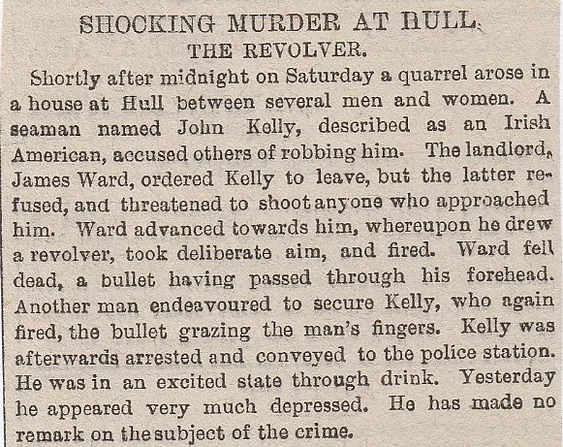
65/ Hull, (Attempted Double Murder/Suicide) July 1885
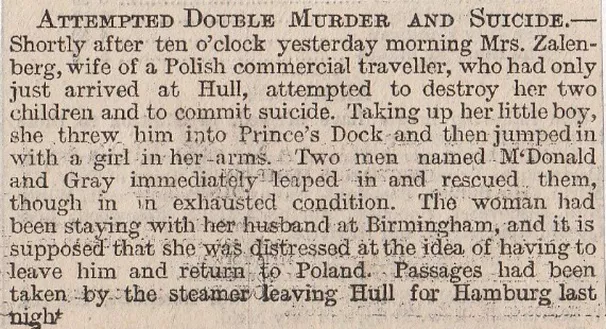
66/ Goole, (Homeless Man Suicide) January 1888
An inquest on the body of Joseph Bedford, seaman, resulted in a verdict of felo de se. Deceased was forty-nine-years-old and had asthma and lived out of a perambulator, which he wheeled about the streets of Goole. One day, fed up with living out of a pram and the sufferings that came with it, he threw himself into the canal and drowned.
67/ North Ferriby near Hull, (Reverend Suicide) June 1891
The body of Reverend Ezra T.Shaw, minister of the United Methodist Free Church in Hull, was found on the bank of the River Humber at North Ferriby. A revolver lay next to him and a gunshot wound was self-inflicted to the side of his head. The Reverend had been in low spirits for some time and is a clear case of suicide.
68/ Wincolmlee Murder/Suicide, Hull, November 1841
A murder/suicide was committed at Wincolmlee, Hull, by Robert Hickson, a deaf and dumb man. He had an argument with Sarah, his wife, when he grabbed a poker and whacked her on the head with it, then killed himself by slitting his throat with a razor.
69/ Humber Bridge Plans, August 1865 (This was being talked about in the 1860’s, same as the Channel Tunnel)
As the survey approaches completion, speculation is rife as to the ultimate object of the promoters. The following hypothesis, founded on well-authenticated data, may be taken as the basis of the scheme:- A bridge from Hessle to Barton at a point nearest to Hessle Windmill, to the cliff formation on the south or Lincolnshire shore, a line of ten miles or thereabouts, connecting the proposed bridge with the existing Trent, Ancholme and Grimsby line, with running powers over the South Yorkshire to Doncaster, and a branch of six miles from Appleby to Santon (both in the same parish) to Kirton, making connection with the Manchester, Sheffield and Lincolnshire Railway in either of the latter parishes, both of which present eligible and easy gradients. The mileage from Hull to Retford would by such a line be reduced by nine miles, and by avoiding a curvature system, a deviation from the Trent and Ancholme in the Appleby Carrs eastward, brings in the hill-side villages; thence to Barnetby, joining the Hull and Lincoln Branch of the Manchester and Sheffield system, thus bringing Hull eleven miles nearer Lincoln and by the Trent twenty-three miles nearer to Doncaster by the North-Eastern and nineteen miles nearer by the Manchester and Sheffield line via Retford, and over the Trent and Ancholme an advantage of twelve to thirteen miles ,thus presenting a prospect of improved mileage in all places.
70/ Withernsea Drowning, August 1864
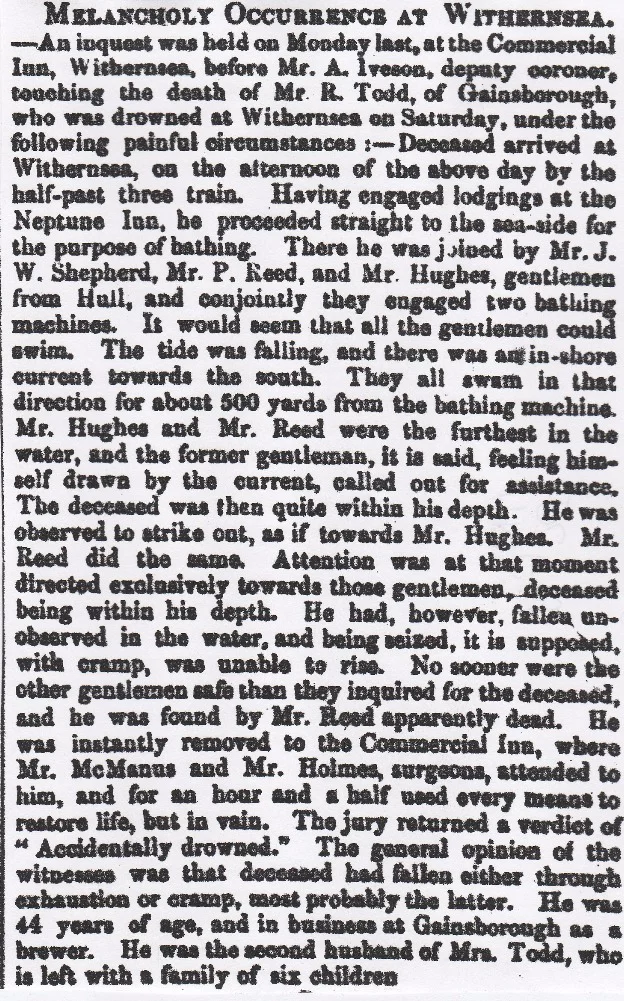
71/ Broomfleet near Brough, (Murder/Suicide) January 1907
A mother, Mrs Arthur Newbourn, got up in the night in her night-dress and carried her baby to the brickyard pond and dived into the water. Both the mother and child were drowned. Since the birth of her child, she had been extremely despondent and she leaves a husband and four other children behind. About two years ago, the mother had one of her children drown in the same place as she did.
72/ Goole, (Attempted Triple Murder/Suicide) July 1908
A married woman named Sawyer got hold of a shilling’s worth of laudanum, which she swallowed most of, then dished out the remainder to each of her three kids. She then got a razor and slit her own throat, severing the windpipe. Sawyer’s life is in the balance, as is that of her eldest daughter who cannot be aroused. (Did they die?)
73/ Beverley Racecourse Manslaughter, June 1910
Charles Brown was committed for trial at the assizes by the Beverley justices, charged with causing the death of Walter Edward Nozedar Rulleyman of Hull, by hitting him on the jaw, on the first day at the Beverley Races. A verdict of manslaughter was returned by the coroner’s jury.
74/ Stamford Bridge near York, (Boating Accident) May 27th, 1899
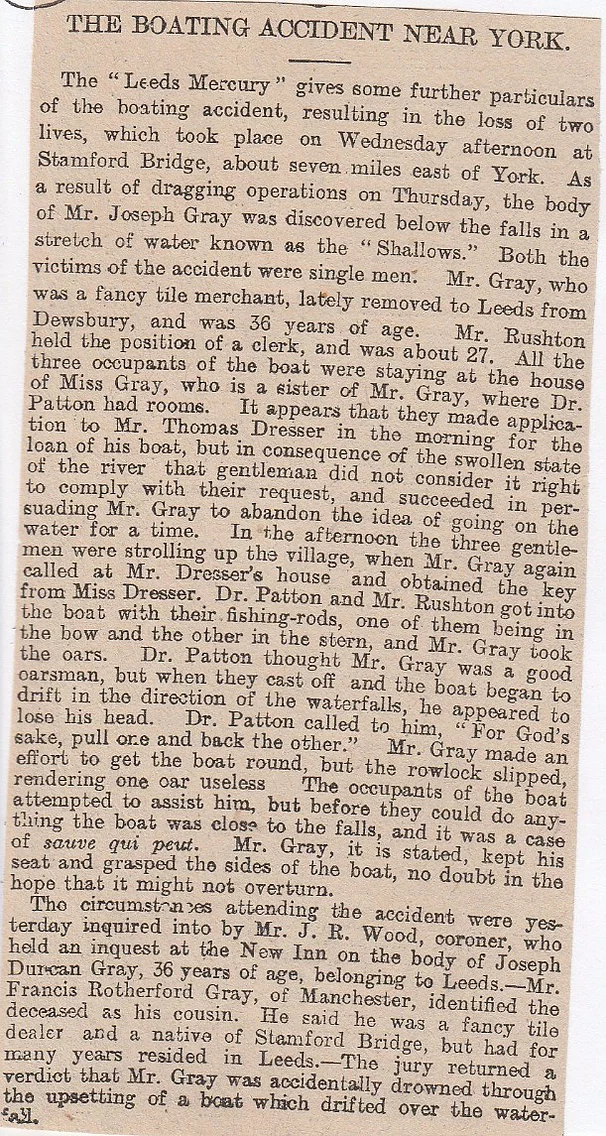
Stamford Bridge Inquest Verdict, May 30th, 1899
An inquest on the body of Albert Rotherford Rushton, Shakespere Street, Manchester, manager of a cotton goods warehouse, who was drowned in the River Derwent on Wednesday last. Along with two companions, Mr Rushton went on the river in a boat to fish. The craft was swept by the swollen current over a waterfall and only one of the occupants, Dr Patton of Stamford Bridge, escaped. The other victim was Mr Gray, a fancy tile dealer from Leeds. A verdict of “Accidental death” was returned.
75/ Temperance Hotel Suicide, Hull, June 1910 (Now the Masters Bar on Jameson St/South Street)
A suicide in the Temperance Hotel, Hull, has caused quite a stir in the city. The body of a forty-year-old man was discovered dead in bed with a revolver by his side and a letter addressed to “whom it may concern”. In the letter, the deceased states that he is the son of Professor Alfred Wahlberg from Stockholm in Sweden. (Was it the professor’s son?)
76/ Flamborough Head Zeppelin Attack, August 1916
The Hull trawler Endymion was fishing off the coast off Flamborough when it was attacked by Zeppelin L 21. The trawler cut her gear and dodged the bombs being dropped by the Zeppelin, which tried a few times but kept missing its target. The trawler eventually crawled back to the Humber but several crew were missing from her, due to the bomb explosions nearly lifting the craft out of the water.
77/ Bromley Terrace, Woodhouse Street, Hull, (Child Murder/Suicide) February 1907
Twenty-eight-year-old Frederick Willingham of Bromley Terrace, Woodhouse Street, Hull, strangled his one-year-old son and then killed himself by hanging. Mrs Willingham had been visiting the dead child of a friend when she came in and found her husband and son. He had been unemployed for some time and had become depressed.
78/ Goole Murder, (Execution of Ellis) August 1896
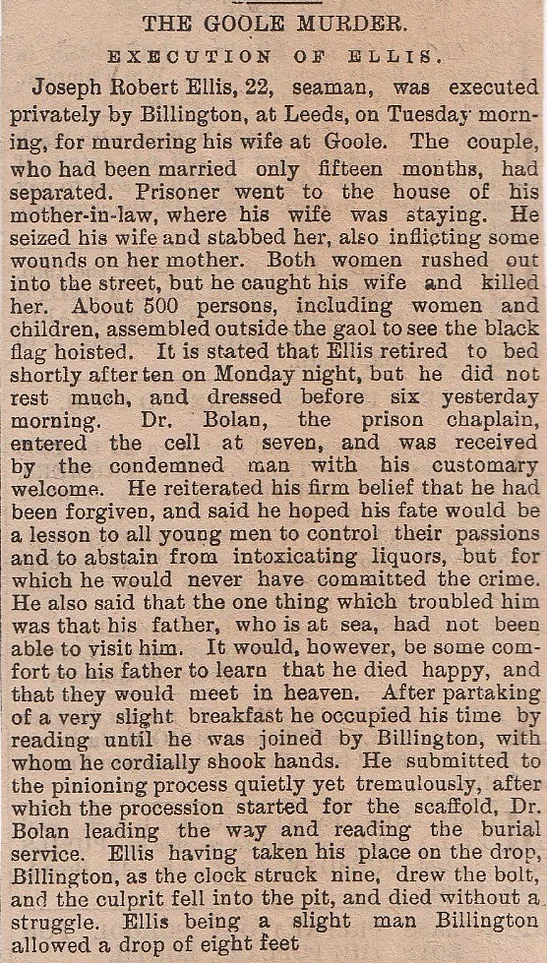
79/ Hull, (Suicide/Attempted Double Murder) May 1891
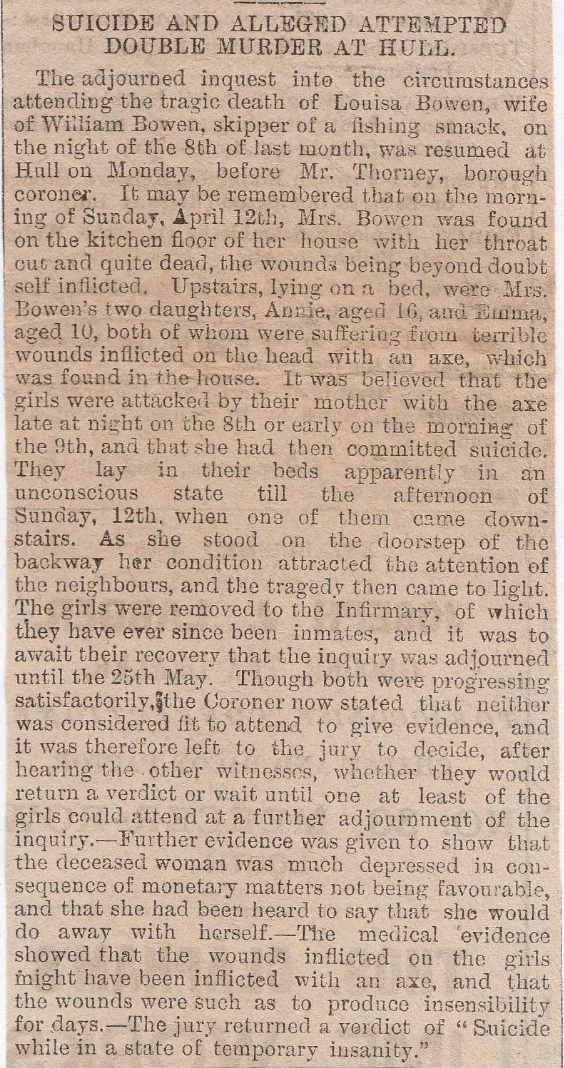
80/ Victoria Timber Pond, Hull, (Three Lads Drown) September 1886
Three lads, named Henry Wildbore aged nine years, Harold Williamson and Harry Salvidge both aged seven, were drowned in the Victoria timber pond, Hull. They climbed on some pieces of timber which formed a frail raft and as soon as they pushed off, the raft disintegrated and the boys sank into ten feet of water. A fourth lad, who stayed on shore, went to get assistance but none of them were visible above the water and after ten minutes or so they were all found, drowned.
81/ Vittoria Hotel Suicide, Hull, December 1877
On the 6th December, a Mr Marmaduke Walter Vavasour, a 43-year-old from Ashby-de-la-Zouch in Leicestershire, checked into the Vittoria Hotel in Hull. He stayed there all the next day and when staff checked on him they found him in a W.C. with a gun in his hand and a bullet hole in his head. He died the next day. The body was identified by the Reverend Vavasour of Snelland in Lincolnshire, as his brother, who said he had suffered from rheumatism for over a decade and was becoming lamer and lamer. He was divorced from his wife and had just had an operation to remove a tumour. All these things had preyed on his mind, plus his son was losing his eyesight and he just decided to end it all. (Where was the Vittoria Hotel?)
82/ Darley’s Court, Hull April 1860
Dr McMillan was in New George Street one morning when he heard a shout of “Stop him!” and he was ushered into Mrs Burnham’s house where he found Elizabeth Ann Parker, sat in a chair bleeding profusely from a wound in her neck. When questioned as to who did it, she replied: “Thomas Kirkwood” and when asked what he does for a living,” A soldier” was the answer. While the doctor tried to stem the flow of blood with his handkerchief torn into strips and giving her tots of brandy to ease the pain, she told him that she had known Kirkwood a month or so but he’d lodged with them for a week. Kirkwood suddenly left one day and his sister told Parker that he was a deserter from the army and she could be held liable to prosecution for harbouring him. He had been gone about a fortnight when he came back yesterday morning, at eight a.m., and stayed till eleven, when he put his arm around her neck and slit her throat. She cried out “Murder!” and died after about an hour or so lingering before she had given important details. Kirkwood was arrested at 12-30 on Spring Bank in front of Minerva Terrace. Kirkwood’s father built the old Adelphi Theatre in Wellington Street (now pulled down) and subsequently the Queen’s Theatre. Parker’s husband died in the Crimea.
83/ River Hull Fatalities, June 1866
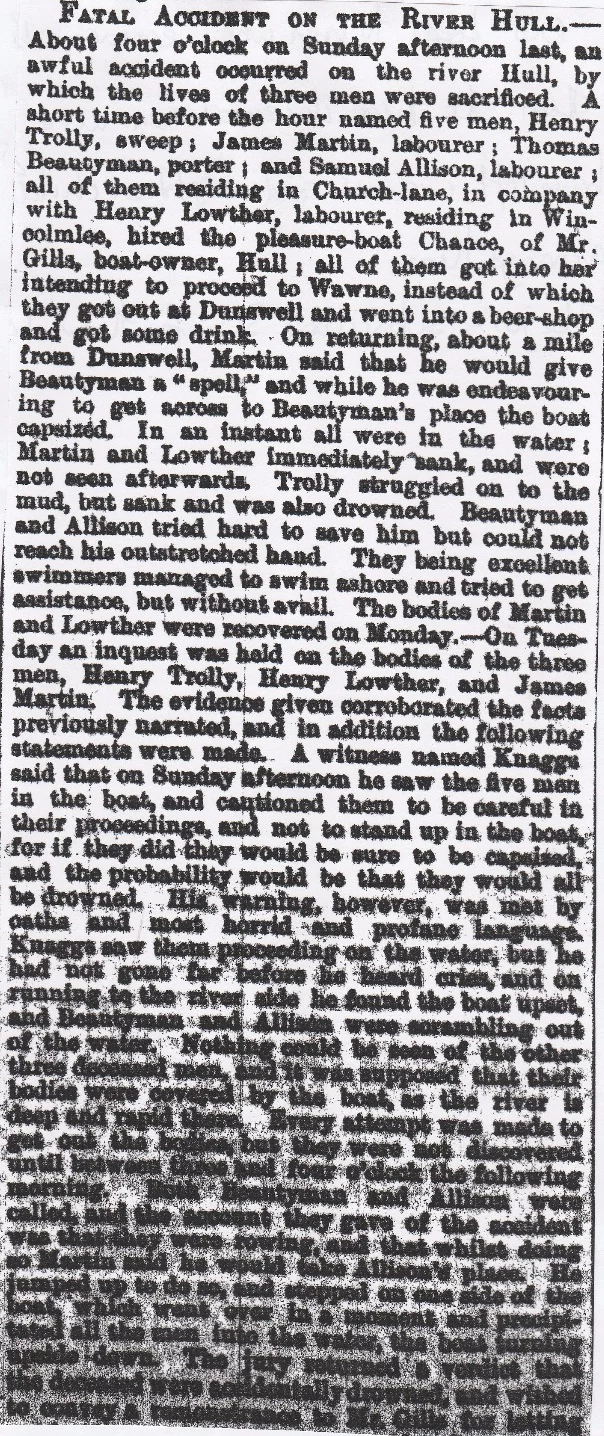
out boats to men who were incapable of managing them.The three deceased men were all married, and have left widows and eighteen fatherless children amongst them.The jury subscribed 30 shillings for the widows and children.
84/ Dock Street Murder, Hull, July 1898
A.G.Stoner, a clerk, was charged with the wilful murder of Emily Hall, who died at the Royal Infirmary last week. Stoner and Hall went to a house in Dock Street and asked for a room. Stoner left the building after an hour or so, leaving Hall behind, and it was the landlady who went up and found Hall in an awful condition. The post-mortem revealed severe internal injuries and the details of this are so gruesome that they cannot be published.
85/ Goole Child Murder, July 1902
Goole police reported a dreadful case of child murder this morning. The wife of a drayman, Anne Morley from Newport Street, Goole, went to bed with her eight-month-old son Walter, at about eleven p.m. At two a.m. she was woken by her father Thomas Ibbetson, who lived with her, entering her bedroom. He had a piece of metal in his hands used for breaking coal, and with this, he threatened to kill his daughter. Ann Morley got free but Ibbetson went to the kiddy lying in bed and struck the child with it. Morley got help and police arrested him, but all too late for the baby who was already lifeless.
86/ Campbell Street, Hull, (Murder/Suicide) October 1902
A woman named Allen was living with a fisherman named Bolton in Campbell Street in Hull. Neighbours got out of bed when they heard screams coming from Allen’s house. They forced the door and found her with knife wounds in her body and she was stone dead. Bolton drew the knife across his throat as they came in and he was later taken to the infirmary, where he lies in a precarious condition. The two of them liked a good drink and were often drunk, but whether this was borne of drink is conjecture at the moment. Bolton is a married man with a large family, and not much hope can be made for his recovery.
87/ Albert Dock, Hull, (Suspicious Death)June 6th, 1885
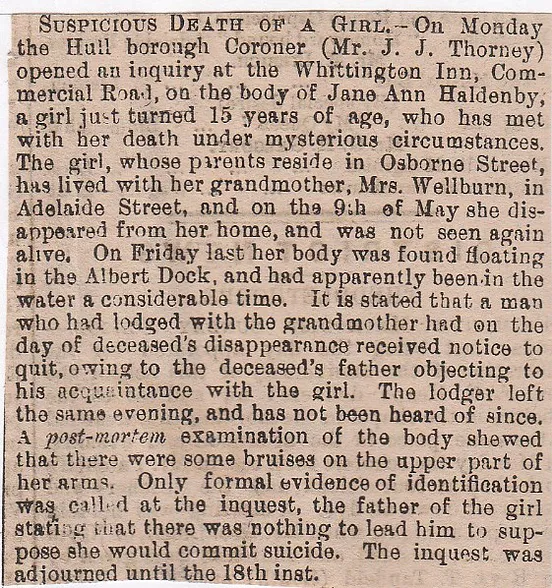
88/ Albert Dock, Hull, July 27th, 1885
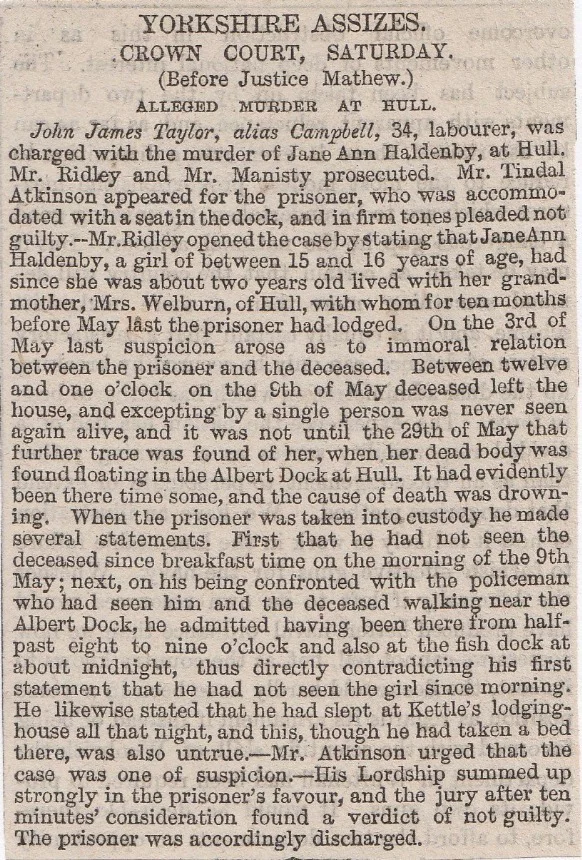
89/ Beverley Child Murders, December 1892
A farmer named George Sowen murdered his two children aged four and six and then committed suicide. Sowen took a farm at Arram near Beverley and on Wednesday night was seen driving towards Hull Bridge. A couple of days later his body was found in the river, with a cow chain around his neck. He also left a suicide note saying that he intended to kill his kids and that his body was to be found in the river. Their bodies have not yet been recovered.
90/ Coniston, (Eaten by Pigs) October 1892
A shocking discovery was made at Coniston, a few miles north east of Hull. Charles Taylor, a gardener who worked for Messrs Dixon and Sons, went to work at daybreak. He must have got to the fold yard then collapsed, because his body was found round about noon. Well, I say body, I mean the remnants of a body, the rest had had been devoured by the pigs. He had been disembowelled and his intestines had been eaten. After the inquest police gave him a decent burial and the whole neighbourhood is in a state of shock.
91/ Hodgson Street Murder, Hull, November 1901
Sarah Hebden, a widow for twenty years, lived on her own in Hodgson Street, Hull. She used to be an insurance agent part-time and one of her clients had been tapping on her door, but getting no answer, so she went to see her sister who lived a couple of doors away. A niece broke into the house through a kitchen window and there she found her Auntie lying face down in a pool of blood, quite dead. The right side of her head had been caved in and nearby was a pair of tongs smeared in blood. The murderer left no clues to his or her identity and the motive is a mystery, as the money and jewellery were left intact.
92/ Hull Revolver Accident, August 1920

93/ Hull Railway Fatality, January 1922

94/ Hull Fish Merchant Suicide, September 1906
A Hull fish and fruit merchant named John Bowen, residing at 101, Walton Street, was found hanging in the kitchen on Tuesday morning. His wife left him about six o’clock to attend the early market and on her return she found him suspended from the bannisters by a piece of cord, tied tightly around his neck. He was cut down immediately but was already dead. Bowen was a well-known man in West Hull and at one time was a bookmaker.
